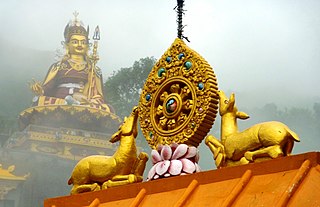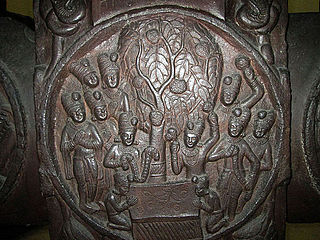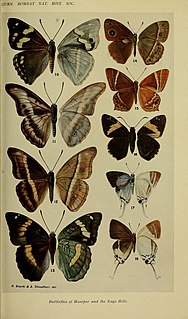
The Nymphalidae are the largest family of butterflies, with more than 6,000 species distributed throughout most of the world. Belonging to the superfamily Papilionoidea, they are usually medium-sized to large butterflies. Most species have a reduced pair of forelegs and many hold their colourful wings flat when resting. They are also called brush-footed butterflies or four-footed butterflies, because they are known to stand on only four legs while the other two are curled up; in some species, these forelegs have a brush-like set of hairs, which gives this family its other common name. Many species are brightly coloured and include popular species such as the emperors, monarch butterfly, admirals, tortoiseshells, and fritillaries. However, the under wings are, in contrast, often dull and in some species look remarkably like dead leaves, or are much paler, producing a cryptic effect that helps the butterflies blend into their surroundings.

The dharmachakra or wheel of dharma is a widespread symbol used in Indian religions such as Hinduism, Jainism, and especially Buddhism.

Calinaga is the sole genus of the monotypic nymphalid butterfly subfamily Calinaginae. Its species occur in South Asia and Southeast Asia. The evolutionary history of Calinaga remains a mystery until today. Recent research indicated that the common ancestor of Calinaga first split in the Eocene in southern China. This was most likely due to a consequence of geological and environmental impacts of the collision of the Indian and Asian subcontinents.

Calinaga buddha, the freak, is a species of butterfly in the Calinaginae subfamily that is found in parts of Southeast Asia, China and in India.

In Buddhist tradition, Vipassī (Pāli) is the twenty-second of twenty-eight Buddhas described in Chapter 27 of the Buddhavamsa. The Buddhavamsa is a Buddhist text which describes the life of Gautama Buddha and the twenty-seven Buddhas who preceded him. It is the fourteenth book of the Khuddaka Nikāya, which in turn is part of the Sutta Piṭaka. The Sutta Piṭaka is one of three pitakas which together constitute the Tripiṭaka, or Pāli Canon of Theravada Buddhism.
According to the Buddhavamsa and buddhist mythology, Sikhī (Pāli) is the twenty-third of twenty-eight Buddhas. The penultimate Buddha of the Alamkarakalpa, Sikhī was preceded by Vipassī Buddha and succeeded by Vessabhū Buddha.
According to Theravada Buddhism's Pali canon's Buddhavamsa and its commentary, Sumedha Buddha is the fourteenth of twenty-seven Buddhas who preceded the historical Gotama Buddha. Sumedha Buddha was born in Sudassana. According to the canon at the age of 9,000 years old he became an ascetic, practiced austerities for fifteen days, and attained Enlightenment. He lived 90,000 years, and died in Medhārāma.

Calinaga aborica, the dark freak or Abor freak, is a species of butterfly in the Calinaginae subfamily that is found in India and the Abor Hills of northern Burma.
The Mahanipata Jataka, sometimes translated as the Ten Great Birth Stories of the Buddha, are a set of stories from the Jataka tales describing the ten final lives of the Bodisattva who would finally be born as Siddharta Gautama and eventually become Gautama Buddha. These jataka tales revolve around Benares, the current Varanasi in India. The final ten are the best known of the total 547 jataka tales. In Cambodia and Thailand, they are known as ទសជាតក and ทศชาติชาดก, respectively. These render the 10 virtues of mankind, that the enlightenment would reveal. These respective virtues are: renunciation, vigour, benevolence, absolute determination, insight, morality, patience, equanimity, reality and generosity.

Calinaga lhatso is a butterfly found in the Palearctic that belongs to the browns family (Nymphalidae). The species was first described by Charles Oberthür in 1893. It is endemic to China.

Calinaga cercyon is a butterfly found in the Palearctic that belongs to the browns family. It is endemic to West China and East Tibet.
According to Theravada Buddhism's Pali canon's Buddhavamsa and its commentary, Sujāta Buddha is the fifteenth of twenty-seven Buddhas who preceded the historical Gotama Buddha. He was also the second Buddha of the Maṇḍa kalpa.






